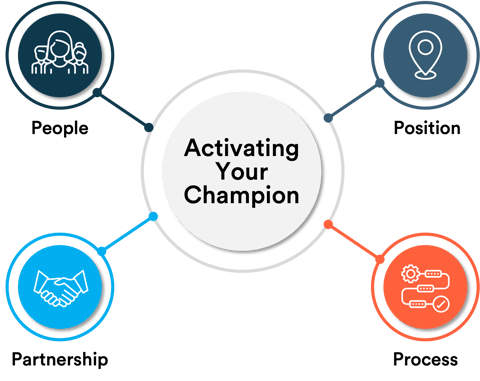Turning Your Most Valuable Asset into Your Most Valuable Player
Our recent pulse survey of more than 300 sellers confirms some hard truths: Deal velocity is slowing. Losses attributed to deferral/no decision are growing. This is no surprise given the prevailing mood of economic uncertainty. Injecting momentum into your deals is critical in hitting this year’s forecast.
Most leaders and sellers understand the importance of Champions. But now more than ever, sellers need to double down on their Champion strategies.
Champions are the Greatest Tool for Derailed Opportunities
Unfortunately, we continue to see some big gaps in how teams leverage Champions. The truth is, too many deal coaching discussions sound like:
- Manager: This deal is clearly stuck. Go work your Champion!
- Seller (in their head): No $#!+! Any specific suggestions on what that looks like?
Let’s assume you’ve identified a strong Champion… that’s a start. But what’s next?
The issue isn’t the what (having a Champion), but the how (the tactical actions that showcase the full benefits of a Champion).
To execute the how, we have a proven model for maximizing a Champion’s effectiveness. It’s focused on specific steps that shift Champions from reactive information-givers to proactive co-sellers.
The 4 P’s of Activating Champions
The Champion Activation Model guides sellers in moving deals forward in collaboration with their Champion. Managers can also use this framework to deliver more efficient and meaningful deal coaching.

Working through the 4 P’s, sellers lead the Champion through the ins-and-outs of their buying journey. Sellers provide valuable insight to Champions via a series of questions related to People, Positioning, Process, and Partnership. The Champion’s answers, especially the quality, and depth, help both parties zero in on tactical steps to take.
Let’s dig deeper.
People
Consensus selling means navigating a wide set of known and unknown influencers. Champions help us identify and work this decision-maker landscape. While some Champions are savvy in this area, many need help.
How can sellers guide Champions to better manage people dynamics and build alignment? It requires an open, question-driven dialogue:
- Test the Champion’s knowledge of the total set of influencers – are they considering all possible players?
- Do they have an accurate view of what different people think about the problem and proposed solution?
- How do they see you as a vendor? Are they advocates, blockers, or perhaps equally bad, neutral bystanders?
- After signing, who might create barriers to successful implementation or solution consumption?
- What internal meetings and conversations have already happened? What needs to happen next?
People questions test the Champion’s grasp and confidence working with various influencers. Each persona likely needs tailored actions – listen closely to how your Champion responds for clues to help you coach your Champion on specific actions for each stakeholder.
Position
In soft markets, sellers must differentiate against alternatives, especially the status quo. This differentiation is your positioning message. And we can’t assume the Champion understands it. We also shouldn’t assume they can effectively communicate it.
Asking Position questions allows sellers to co-create the pursuit strategy and message with the Champion. These can also confirm that the Champion has proof points and collateral to communicate our value.
- What does the customer need to believe in order to act? Is the issue seen as a nice-to-have or a must-do?
- Are you being evaluated against others? If so, who? How can you emphasize the daylight with competitors?
- What does the Champion see as your competitive differentiation? Is this an accurate and objective view?
- Given the strengths of the competition, does the Champion know ways to reframe the problem or solution? Are there options to reposition?
- How do the perception of you and your solution differ by stakeholder?
Be wary of a Champion who can’t answer or discuss these topics with any depth. Coach them on how to frame the problem and/or your solution. This questioning also helps the Champion further tailor the message to different stakeholders.
Process
How often does it feel like the goalposts keep moving? IT introduces additional technical requirements… finance demands even more detailed ROI projections… there are last-minute legal or procurement asks.
Champions should help us stay ahead of these action steps. Many times, Champions need education on how to uncover the decision details. This involves frank discussions to get all Process specifics on the table early. Again, questions are a powerful way to do just that.
Process questions include:
- What did the process look like when your organization procured a solution of similar size/importance?
- What’s the stated internal contracting and paper process? How does that vary when off vs. on budget cycle?
- What function seems to present the most hurdles or is most difficult to manage? Why?
- How do we get ahead of potential legal and technical reviews? Is there paperwork or other steps to complete now?
- What other process steps could we take now to smooth the transition to implementation?
Work with your Champion to clarify the process, but also to get ahead of future asks. Watch for clues that your Champion isn’t fully aware of the decision process or must work hard to uncover process details. This might suggest you’re not as far along as you think in the deal.
Partnership
Modern selling means active collaboration with your Champion. They should have skin in the game. They need to feel personal ownership for the positive outcome of the deal. Equally, they should sense a degree of personal risk if the deal falls through.
Partnership is all about increasing the Champion’s psychological commitment to our solution. Sellers should use “we-language” when they interact with their Champion. Incorporate “we” into a set of Partnership questions aimed at building Champion confidence and ownership:
- How can we work together to get this decision across the line?
- How can we best document and track our mutual success plan?
- How will a win benefit you – your position, reputation, and influence within the organization?
- How confident are you in handling potential pushback and questions from other influencers? Do we need to practice some potential objections and good responses?
Lack of personal ownership by a Champion means sellers haven’t effectively communicated the value of a partnership. Even worse, it may be a signal that they’re advocating for other solutions instead of our own.
Activating Champions for Success
Champions continue to be the most under-utilized tools in a seller’s toolkit. Larger opportunities and accounts often require multiple Champions. Over-reliance on a single Champion can be a risk, especially in today’s highly fluid job market. Use the 4 P’s to convert average contacts into deal-driving Champions.
Additional InSIGHTS
Q: How do you identify and nurture potential Champions within an organization?
A: Recognizing potential Champions involves a proactive approach. Sellers can start by closely analyzing the decision-maker landscape and engaging in open, question-driven dialogues with individuals who show influence.
Most sellers can benefit from a more transparent conversation with potential Champions about their willingness to engage others, bring leadership to the meeting or help you navigate additional stakeholders and information. Through this questioning you’re de-risking your deal by testing and developing a Champion.
The goal is to build rapport and trust over time. This allows sellers to understand the potential Champion’s perspective, alignment with the organization's goals, and influence to navigate internal decision process.
Q: How do sellers use the 4 P's model for Champion activation to de-risk deals?
A: Sellers will likely encounter some resistance such as initial skepticism from stakeholders, organizational inertia, or unforeseen complexities in the sales process.
The 4 P’s model provides a framework for sellers to test their deal for risk. Most deal risk centers on the successful activation of a Champion. No Champion, no deal!
We recommend that at early, mid and lates stages of the deal managers are assessing resistance in Champion’s ability to help us with People, Position, Process, or Partnership. As deal risks are identified in each area, Manager and Sellers should be working together to develop and deploy specific selling strategies to close those gaps.
By sharing experiences of overcoming challenges and providing practical strategies, sellers can enhance their ability to effectively apply the 4 P's model and maximize the impact of Champions on deal progression and success.
Q: How can sales leaders ensure consistent adoption of the Champion Activation Model across their teams?
A: Sales leaders play a pivotal role in fostering the consistent adoption of the Champion Activation Model. The most effective strategies include providing comprehensive enablement, tools and content for teams to use.
Your Champion activation playbook should include:
- Success stories
- Connecting current customers with prospective buyers
- Use of digital sales rooms to share content with Champions
- Consistent use of Champion presentations that can be used to socialize the opportunity internally
- Email templates to connect executives between the two organizations
- Executive briefings and marketing events
Additionally, incorporating the model into 1:1s, QBRs and recognizing those who effectively utilize it reinforces its importance within your sales culture.
Contact us to learn more about how sales organizations are maximizing Champion strategies in today’s environment. As a refresher, use our Champion guide to ensure your teams are collaborating with the right Champion candidate.
About The Author
 Researcher, consultant, and sales leader, Brian uses a data-driven approach to drive sales effectiveness. His clients include leading sales organizations in financial services, technology, healthcare, and professional services. Using insight from academics and change management, Brian helps senior leaders and sales enablement teams understand and succeed in today’s more demanding market. His research has been published in Harvard Business Review and other outlets.
Researcher, consultant, and sales leader, Brian uses a data-driven approach to drive sales effectiveness. His clients include leading sales organizations in financial services, technology, healthcare, and professional services. Using insight from academics and change management, Brian helps senior leaders and sales enablement teams understand and succeed in today’s more demanding market. His research has been published in Harvard Business Review and other outlets.




